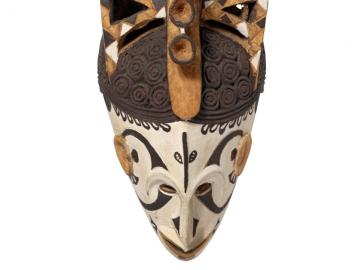Painted wooden maiden mask

(c) Pitt Rivers Museum, University of Oxford
Date: By 1953
Culture: North central Igbo
Country of origin: Nigeria
Accession number: 1972.24.67
Location: Court, Nigerian Masks and Masquerade Case (5.A)
Online record: http://bit.do/maidenmask
This is an example of a painted wooden mask from the Nri Awka region of Igboland in south east Nigeria known as ‘maiden masks or maiden spirit masks’. The masks are typically worn for social regulation, during agricultural cycles and in funerary processions. Masks are carved to highlight the petite features of young women and painted with a white chalk substance to represent a pale complexion, giving the mask a spiritual, ghostly quality. Masks are accompanied with multi coloured, close fitting, appliquéd costumes and topped with an elaborate hairstyle, embellished with representations of hair combs modelled after 19th century ceremonial hairstyles. The ‘fame of the maiden’ masquerade is used to educate young girls in what is considered to be the African ideal of physical and moral beauty. It is perhaps surprising, therefore, that these costumes are actually worn by young adult males who, when dressed as beautiful maidens, mimic, in exaggerated performance, typical female gestures and behaviour.
G R Mills
Read more about Agbogho Mmanwu masks by G R Mills
Igbo masks are not just beautiful objects of art, but also important spiritual tools. They give full protection to the person wearing the mask as they embody its spirit when worn during a masquerade. This example is a maiden mask carved from a single piece of softwood and can be identified as female because of its name (Agbogho are maidens known for their beauty), ornate hairstyle, white face and small delicate symmetrical features. They are usually worn by men aged 30-50 from the Igbo people of Nigeria during the Agbogho Mmanwu (Maiden Masquerade). Masquerades are a central part of Igbo life offering reflection, moral insights and entertainment to the community. Men wearing female masks show an understanding of gender and sexuality that does not readily fit into modern European definitions. This fluidity is a celebration of the many ways of being.
JC Niala
Images